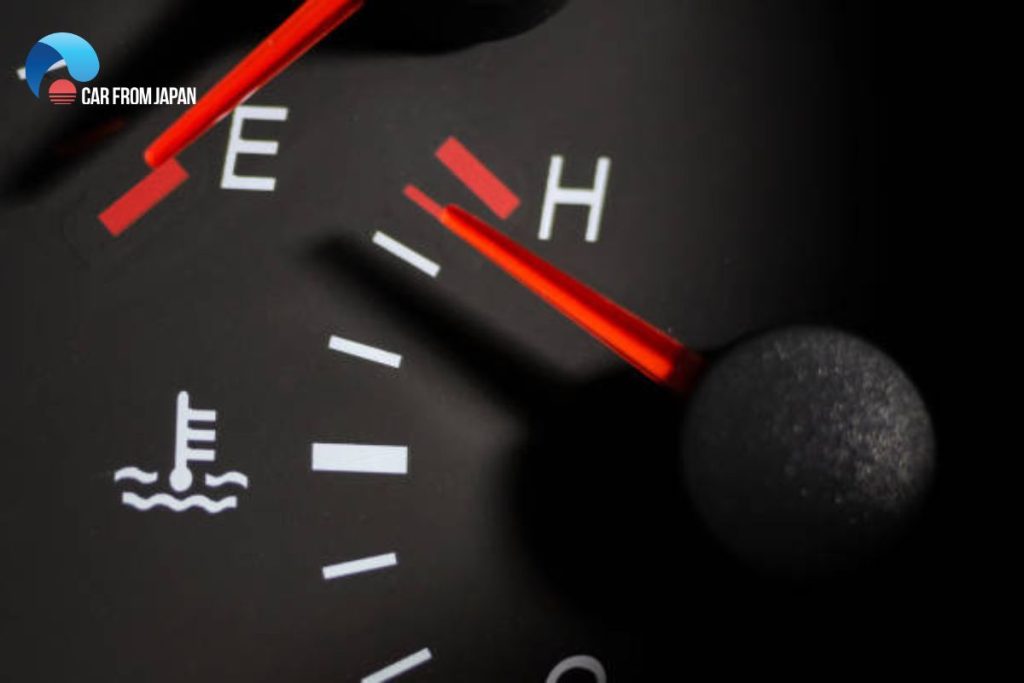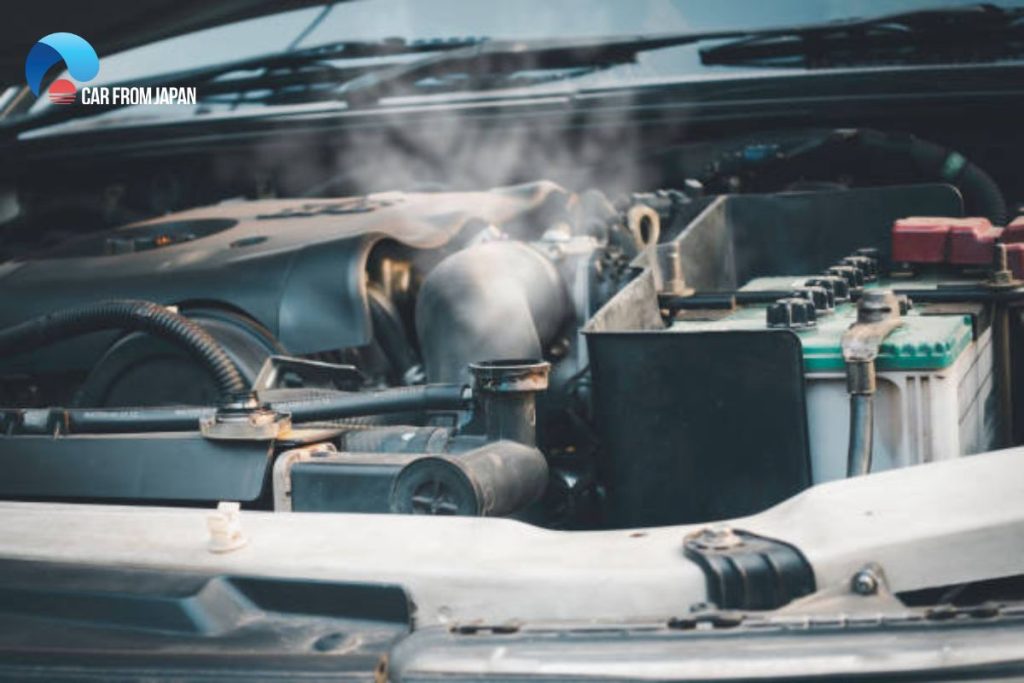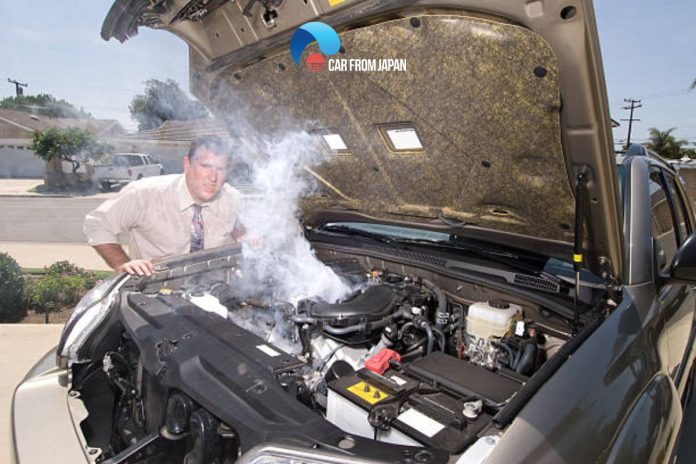Engine overheating is a dangerous and not uncommon problem. When experiencing this situation while driving, what should you do? Keep driving or pull over? If you continue driving, how far can you drive an overheating car? Understanding your concern, we will make everything clear on this topic.
Contents
What Happens When Your Car Overheats?
The internal combustion engine, while burning fuel to generate energy, will make a large amount of excess heat. If not cooled in time, the engine will overheat, posing the risk of fire and explosion, causing danger to users. Overheating is one of the most dangerous engine errors that drivers need to be aware of during vehicle operations. How can you tell if your car is overheating? There are some symptoms you can easily notice:
Warning light on the dashboard
You can observe on your car dashboard when the temperature gauge on the dashboard increases. Most drivers often ignore the warning signals given by the dashboard, but we must pay attention to them. Normally, when your car starts to overheat, the check engine light will come on to notify the driver.

Smoke and steam from your engine
When you see steam or smoke coming from under the hood, you need to stop the car immediately. There are a number of other reasons that lead to this condition such as an oil leak that burns the engine or an overheated vehicle. Therefore, you should take your car to the repair center to find out the exact cause.
Burning smell
When you smell strange odors like a burning smell, it can be a sign to tell that your car is overheating while driving. Your engine is completely filled with lubrication oils, rubber gaskets, or metal components. So if your engine is overheating, you will smell a burning sensation from all of these things: burning rubber or burning metal…
How Far Can You Drive an Overheating Car?
You can feel panic when noticing the warning light or the temperature gauge continues increasing on your car dashboard while driving. And the most concern at this time is how long a car can overheat before damage, which can help you make the right decision, you should keep driving or stop immediately. Let’s find the most desired answer in this part!
There is no exact mileage to drive the car when your car is overheating. The key factor you should know is how much it overheats:
- If the temperature gauge shows a little above the N (normal) mark, you don’t need to worry. This usually occurs in hot weather when the outdoor temperature is higher than your cooling system.
- In the second case, when the gauge needle is between the N and H (hot) marks, you need to pull over to the side of the road, shut your engine, and wait for the engine to cool down for 20-30 minutes.
Note: Don’t open the radiator cap immediately when your car is overheating. Because at that time, there is a lot of pressure in the cooling system and if you open the radiator cap, the pressure and hot water (about 210 degrees) will come out and it’s very dangerous for you. Let’s wait until your engine cools down before opening the radiator cap.
- When you drive at high speed and the needle on the temperature gauge moves toward the “H” mark and goes past the 3/4 mark, you should pull over immediately and shut off your engine. At that time, you had around 30-60 seconds before your engine started to have serious damage.
However, most experts said that when your engine begins to overheat, you will have around 1 minute to 5 minutes before your engine is damaged, however, within 30 to 60 seconds, it may have already started to cause a little problem to your engine (valve or piston) that may completely damage the engine. Corresponding to this time interval, the furthest distance you can drive when your engine is overheated is about 1/4 mile before your engine is completely ruined.
How To Fix an Overheating Car While Driving?
As soon as the driver notices engine overheating signs (the engine temperature gauge needle indicates an overheating), the driver needs to immediately turn off the air conditioning system or the heating system on the vehicle to reduce the temperature of the engine compartment quickly.

Then quickly park the vehicle on the curb or emergency lane on the highway, turn off the engine, and check the engine and cooling system of the vehicle. If you want to check the coolant, you need to wait for the engine to cool down completely (about 20-35 minutes after turning off the engine), then turn the water tank slightly counterclockwise to release excess pressure, then open the cap.
In case you are in traffic if you encounter an engine overheating, accelerate the throttle a bit after shifting to P or N. This process boosts the water pump and fan, helping to have a better speed.
At that time, more air and water pass through the radiator, helping the engine to cool down faster. Experts also advise that when participating in traffic encountering congestion, try to control the car slowly instead of accelerating and braking continuously. Braking will make overheating worse, possibly damaging the engine.
These are some temporary fix for overheating car you can apply when experiencing this problem. When doing all of the above steps and the engine still has no signs of cooling down, it is best to drive to the side of the road and turn off the engine to let the engine cool down gradually.
Engine overheating is not an easy situation to deal with, you should take your car to the garage as soon as possible to have the cooling system checked. Pay attention when the vehicle is overheated; do not drive too far to further damage the engine. If possible, add coolant before moving to the nearest repair center.
To avoid overheating of the car engine, the vehicle needs to be periodically maintained, especially by checking and changing the coolant solution, ensuring the water level is always at a safe threshold, and not letting the water drop below the “min” mark in the tank. Besides, the engine also needs oil added regularly.
How Long Does It Take For Engine To Cool Down?
As we mentioned above, it typically takes you about 30 minutes to cool down enough your engine and to be safe to make another process. If you’d rather let a professional handle the problem, it’s time to call the tow truck. Once the engine is cooled, check the coolant tank.
To cool down your engine fastly, first, you should put your car in neutral (N) or park (P), then rev your engine. This makes the fan and the water pump work faster, which pulls more air and more water through your car’s radiator. This increased circulation cools down the engine.
FAQs
Should I drive slowly if my car is overheating?
No, continuing to drive, even slowly, when your car is overheating can cause severe engine damage. You should pull over to a safe location as soon as possible and turn off the engine. Allowing the engine to cool down is crucial to prevent further issues.
How long should I wait if my car overheats?
You should wait at least 15 to 30 minutes, and ideally longer, for the engine to cool down significantly after it overheats. This allows components to cool enough to be safely inspected, like checking the coolant level (once the radiator cap is cool to the touch). Rushing this process can lead to burns or make it difficult to assess the problem.
How to safely drive an overheating car?
When dealing with an overheating engine, drive for short distances, then turn off the car to cool it down, repeating this cycle as needed. Always watch the temperature gauge closely so you know when to stop and let it cool more thoroughly.
Final Thoughts: How Far Can You Drive an Overheating Car?
A lot of time, some drivers want to save their money from getting a tow, so they keep driving to find the repair center. Unfortunately, in our line of work, we see many cars to keep driving and end up being a large repair: a cylinder head gasket repair or a car motor or something significant and that’s not very cheap for repairing (the average cost to fix an overheating car varies, typically between $100 to $1500).
To wrap up this topic, we want to emphasize that you shouldn’t keep driving when noticing any symptoms of an overheating engine.



